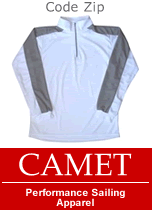
Photo Copyright OnEdition
Southern Spars - David Barnaby
Challenging a sailor’s every ounce of energy and adrenalin, the Open 60 is one of the fastest monohull classes in the world. Moreover this is a class that continues to evolve, explores new design innovations and technology and sets the standards for other classes. The development of the rig in this class is no exception. David Barnaby, a designer for Southern Spars, who resides in Europe, explores some of the advancements in rig design and technology.
Since the inception of the Open 60 class many rig geometries have been developed and presently there are three popular configurations. However several common factors are crucial to a rig’s success regardless of geometry; reliability, rig control, and weight.
Reliability – Crucial in any round the world race, but particularly in the Vendee as a single-handed masthead climb is not easy unless you are an octopus, and being a non-stop race, any unreliable equipment will likely be a handicap for 3 months. With any round the world race there is much talk prior regarding weight savings, and yet for the year after there are many grumblings about reliability.
Control – the key being that the skipper controls the rig and not vice versa. Stiffness without excess weight is crucial. Geometry is also an important factor for all sail configurations because if any of these combinations are compromised by a lack of rig stability, then the performance is less than optimum. In previous generations the rigs have been super light and consequently soft, which has been a function of the ‘no rule’ limit on mast weight. As a result, the yacht experienced poor upwind performance due in part to massive headstay sag. With the development of lighter rigging, stiffer boats, better rig geometries and centreboards, the class has started to attract more attention for its upwind capabilities. Being able to gybe with slackened runners is also a design prerequisite.
Weight – a function of the rule is that if all boats were identical apart from the rig then the boat with the lightest rig would theoretically have the greatest righting moment and therefore potentially be the fastest. This is unlike Volvo or Americas’ Cup where all rigs weigh the same and the only performance gain is drag. History has proven that if applied correctly, righting moment is king.
The Rig Geometries
1) Classic non-rotating rig geometry – 2, 3 or 4 fixed spreaders generally produce the lightest possible package. These rigs provide good control throughout the various sail configurations. Occasionally we see these spreaders able to rotate which eases the torque induced by the mainsail during a gybe.
2) Swinging spreader wing – this has been popularised by the Ecover style package, featuring one or more swinging spreaders, which gives the drag reduction of a wing but has the more ‘locked on’ control characteristics of a classic rig.
3) Deck spreader wing – this is a low drag option due to minimal rigging. The chainplates, being at the end of wide deck spreaders, allow wide shroud angles. This geometry is probably the heaviest option, however interestingly provides the lowest VCG and heeling moment as the deck spreaders are heavy but low down. This geometry has a tendency for instability fore and aft as it is not locked in with spreaders. The only way to stabilise this is by having a longer chord length mast which adds weight. A nice product of the deck spreader geometry is the ability to sheet the reaching sails off the deck struts. http://www.southernspars.com/
Challenging a sailor’s every ounce of energy and adrenalin, the Open 60 is one of the fastest monohull classes in the world. Moreover this is a class that continues to evolve, explores new design innovations and technology and sets the standards for other classes. The development of the rig in this class is no exception. David Barnaby, a designer for Southern Spars, who resides in Europe, explores some of the advancements in rig design and technology.
Since the inception of the Open 60 class many rig geometries have been developed and presently there are three popular configurations. However several common factors are crucial to a rig’s success regardless of geometry; reliability, rig control, and weight.
Reliability – Crucial in any round the world race, but particularly in the Vendee as a single-handed masthead climb is not easy unless you are an octopus, and being a non-stop race, any unreliable equipment will likely be a handicap for 3 months. With any round the world race there is much talk prior regarding weight savings, and yet for the year after there are many grumblings about reliability.
Control – the key being that the skipper controls the rig and not vice versa. Stiffness without excess weight is crucial. Geometry is also an important factor for all sail configurations because if any of these combinations are compromised by a lack of rig stability, then the performance is less than optimum. In previous generations the rigs have been super light and consequently soft, which has been a function of the ‘no rule’ limit on mast weight. As a result, the yacht experienced poor upwind performance due in part to massive headstay sag. With the development of lighter rigging, stiffer boats, better rig geometries and centreboards, the class has started to attract more attention for its upwind capabilities. Being able to gybe with slackened runners is also a design prerequisite.
Weight – a function of the rule is that if all boats were identical apart from the rig then the boat with the lightest rig would theoretically have the greatest righting moment and therefore potentially be the fastest. This is unlike Volvo or Americas’ Cup where all rigs weigh the same and the only performance gain is drag. History has proven that if applied correctly, righting moment is king.
The Rig Geometries
1) Classic non-rotating rig geometry – 2, 3 or 4 fixed spreaders generally produce the lightest possible package. These rigs provide good control throughout the various sail configurations. Occasionally we see these spreaders able to rotate which eases the torque induced by the mainsail during a gybe.
2) Swinging spreader wing – this has been popularised by the Ecover style package, featuring one or more swinging spreaders, which gives the drag reduction of a wing but has the more ‘locked on’ control characteristics of a classic rig.
3) Deck spreader wing – this is a low drag option due to minimal rigging. The chainplates, being at the end of wide deck spreaders, allow wide shroud angles. This geometry is probably the heaviest option, however interestingly provides the lowest VCG and heeling moment as the deck spreaders are heavy but low down. This geometry has a tendency for instability fore and aft as it is not locked in with spreaders. The only way to stabilise this is by having a longer chord length mast which adds weight. A nice product of the deck spreader geometry is the ability to sheet the reaching sails off the deck struts. http://www.southernspars.com/







